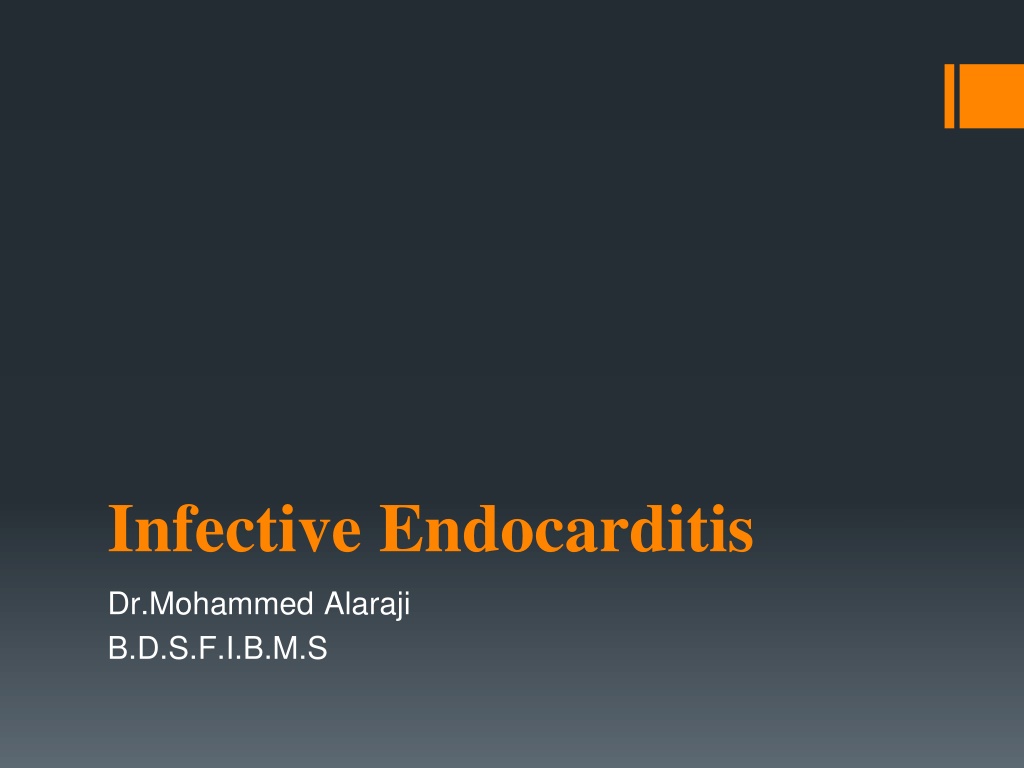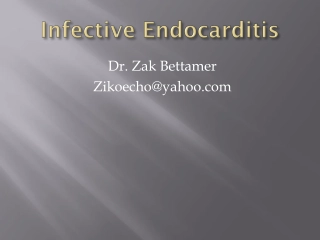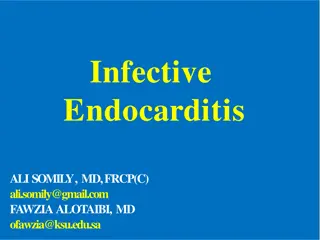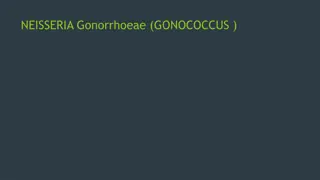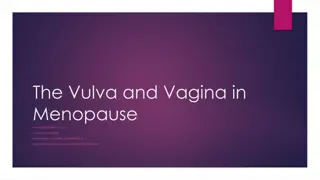Understanding Infective Endocarditis: Causes, Symptoms, and Management
Infective Endocarditis (IE) is a microbial infection of the heart's endothelial surface or valves. Streptococci and Staphylococci are common causative agents. Predisposing conditions include heart defects and valve diseases. IE presents with symptoms like fever, heart murmurs, and petechiae. Diagnosis involves blood cultures and imaging for endocardial involvement. Dental management is crucial to prevent IE in high-risk patients undergoing invasive procedures.
Download Presentation

Please find below an Image/Link to download the presentation.
The content on the website is provided AS IS for your information and personal use only. It may not be sold, licensed, or shared on other websites without obtaining consent from the author. Download presentation by click this link. If you encounter any issues during the download, it is possible that the publisher has removed the file from their server.
E N D
Presentation Transcript
Infective Endocarditis Dr.Mohammed Alaraji B.D.S.F.I.B.M.S
Infective endocarditis (IE) is defined as a microbial infection of the endothelial surface of the heart or heart valves that most often occurs in proximity to congenital or acquired cardiac defects. Although bacteria most often cause these diseases, fungi and other microorganisms may also cause infection. the term infective endocarditis (IE) is used to reflect this multimicrobial origin.
Predisposing conditions attributed to IE Mitral valve prolapse Aortic valve disease Congenital heart disease Prosthetic valve
Etiology Streptococci are the most common cause of IE 30%-65%, of which n (alpha-hemolytic streptococci), which are normal constituents of the oral flora and gastrointestinal tract. Staphylococci are the cause of at least 30%-40% of cases of IE; mostly coagulase-positive Staphylococcus S. aureus has also recorded. Other microbial agents that less commonly cause IE such as the HACEK group (Haemophilus, Actinobacillus, Cardiobacterium, Eikenella, Kingella). Bacteroides fragilis, and fungi.
Signs and symptoms Fever (most common). Heart murmur. Petechiae of the palpebral conjunctiva, the buccal and palatal mucosa. small, erythematous or hemorrhagic, macular Non tender lesions on the palms and soles). Splinter hemorrhages in the nail beds Roth spots (oval retinal hemorrhages with pale centers) Splenomegaly Positive blood cultures in most cases.
Diagnosis I. Positive blood cultures. II. Evidence of endocardial involvement (e.g., positive echocardiography, presence of new valvular regurgitation.
Dental management identification from history the risk group patients with cardiac conditions that increase risk for IE. The basic assumption is that IE is most often due to a bacteremia that results from an invasive dental procedure, and that through the administration of antibiotics prior to those procedures, IE could be prevented. The following procedures and events do not need prophylaxis: 1. routine anesthetic injections through noninfected tissue, restorative dentistry, dental radiographs, placement of removable prosthodontic or orthodontic appliances, placement of orthodontic brackets, shedding of deciduous teeth, suture removal, fluoride treatment. 2. Preoperative use of 0.2% Chlohexidine mouth washes is Advisable. 3. In case of prolonged dental procedures (longer than 6 hours) it is advisable to administer an additional prophylactic dose (same dose).
Antibiotic Prophylaxis Regimens All doses shown below are administered once as a single dose 30-60 min before the procedure. Standard general prophylaxis Amoxicillin Adult dose: 2 g PO Pediatric dose: 50 mg/kg PO; not to exceed 2 g/dose Unable to take oral medication Ampicillin Adult dose: 2 g IV/IM Pediatric dose: 50 mg/kg IV/IM; not to exceed 2 g/dose
Allergic to penicillin Clindamycin Adult dose: 600 mg PO Pediatric dose: 20 mg/kg PO; not to exceed 600 mg/dose Allergic to penicillin Cephalexin or other first- or second-generation oral cephalosporin in equivalent dose (do not use cephalosporins in patients with a history of immediate-type hypersensitivity penicillin allergy, such as urticaria, angioedema, anaphylaxis) Adult dose: 2 g PO Pediatric dose: 50 mg/kg PO; not to exceed 2 g/dose Azithromycin or clarithromycin Adult dose: 500 mg PO Pediatric dose: 15 mg/kg PO; not to exceed 500 mg/dose
Allergic to penicillin and unable to take oral medication Clindamycin Adult dose: 600 mg IV Pediatric dose: 20 mg/kg IV; not to exceed 600 mg/dose Cefazolin or ceftriaxone (do not use cephalosporins in patients with a history of immediate-type hypersensitivity penicillin allergy, such as urticaria, angioedema, anaphylaxis) Adult dose: 1 g IV/IM Pediatric dose: 50 mg/kg IV/IM; not to exceed 1 g/dose
Rheumatic fever and rheumatic heart disease
Rheumatic fever is an autoimmune inflammatory process that develops after pharyngeal infection with group A beta-hemolytic streptococci (streptococcus pyogenes). It predominantly affects children between 5- 15 years. Rheumatic fever may occasionally be followed by chronic rheumatic carditis with permanent cardiac valvular damage that appears to be immunologically mediated tissue damage, which may lead to fibrosis and distortion of the cardiac valves (chronic rheumatic heart disease).
It is also extremely important for the dentist to realize that transient bacteremia, which in healthy patients is nonthreatening and which may develop after invasive surgical procedures, is considered especially dangerous for patients belonging to this category. In this case, the endocardium generally presents great sensitivity to bacterial infection, and, as a result, any invasive procedure in the oral cavity without the use of antibiotics results in greater risk of bacterial endocarditis.
Dental management Acute rheumatic fever patients are exceedingly unlikely to be seen during an attack but emergency dental treatment may be necessary. Patients with history of rheumatic fever but without cardiac involvement are treated as a normal person. Most patients with chronic rheumatic heart diseases are anticoagulated and they should be managed after determining their prothrombin time and INR and the treatment can be done under local anesthesia with vasoconstrictor in consultation with the physician. Conscious sedation with nitrous oxide may be given if cardiac function is good and with the approval of the physician. Prior to any surgical intervention,prophylactic antibiotics are used.
